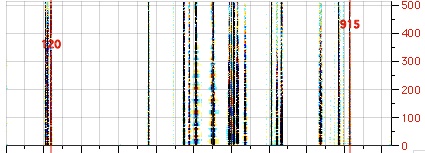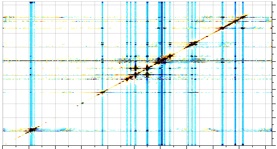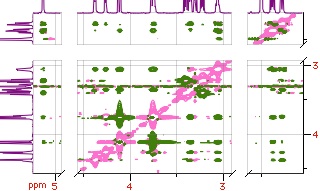Example of 2D Spectroscopy Workflow: Phase Sensitive Spectra
From the processing point of view, there are two classes of 2D spectra: phase-sensitive and non phase-sensitive. We'll limit ourselves to the former, more difficult case. As an example we'll process a ROESY spectrum acquired in States-TPPI mode on an Avance spectrometer. iNMR is so fast and its displays are so accurate that an expert spectroscopist will prefer to perform processing while looking at the whole 2D matrix. For the beginner, with only 1D experience, it is however more convenient to extract rows and columns. The latter approach will be followed here.
Extract the bottom row |
|
 |
Option-click to create a mark. Select the command “File/Extract”. |
Fourier Transform the 1D Extract |
|
 |
iNMR has already chosen appropriate parameters. We simply accept them. |
Phase Correct the 1D Extract |
|
 |
The picture shows many things: when you correct the phase, amplify heavily the spectrum; no peak should have an asymmetric tail; due to its particular pulse sequence, half of this spectrum has a reverted phase, that's OK. |
Repeat FT on the whole matrix |
|
 |
Select the command “File/Close Extract”. When you close the extract, the parent matrix is still in frequency domain. You only need to repeat FT; phase correction is performed automatically, using the same parameters you have optimized for the first row. |
Extract a few, chosen, columns |
|
 |
To optimize processing along the indirect dimension, choose at least one signal on the left and one on the right, as shown here. Create vertical marks by Cmd-clicking, then select the same command “File/Extract”. |
FT the interferogram along the indirect dimension |
|
 |
This time too iNMR has chosen appropriate parameters, that we accept. Note that our ROESY was acquired in “States-TPPI” mode. This is the only case in which neither “Swap Sides” nor “Real FT” are selected. |
Phase along indirect dimensions is predetermined |
|
 |
We don't need to search the phase correction values. They are already known in advance. We can also choose a value of zero for the zero-order phase correction. It corresponds to a sign change. |
Back to the Whole (Transposed) Matrix |
|
 |
Close the extract and apply the FT to the whole matrix. This time iNMR will transpose the matrix. It may still be the case of changing the phase of 0.1-0.5 degrees. You can refine phase in both dimension, either after other extractions or, better, directly on the whole matrix. |
Baseline Correction |
|
 |
You want to remove the vertical stripes. Select the command “Process/Automatic Baseline”. Select parameters such those shown. then Hit “OK” |
The Spectrum Cleaned Up |
|
 |
Calculations can stop here. Remember to reference the frequency scale against TMS. The command is “Format/Axes & Scales”. There is a button to copy directly the reference information from the 1D spectrum, if open. Finally switch to the contour plot, change colors, zoom, cut, do whatever you like... |
Enjoy ! |
|
 |
Processing by yourself is more funny than having everything done by the computer... ...actually processing by yourself is the only option you have ! Also read how you have the 1D projection drawn along the sides: |